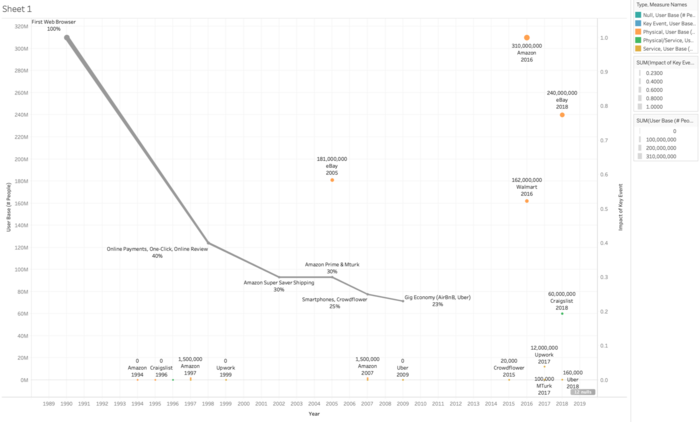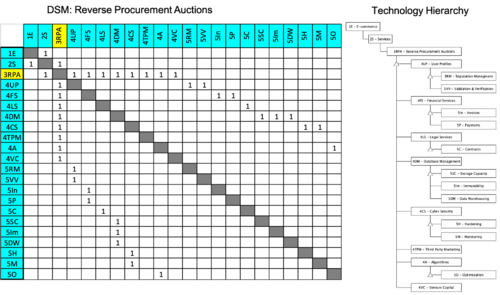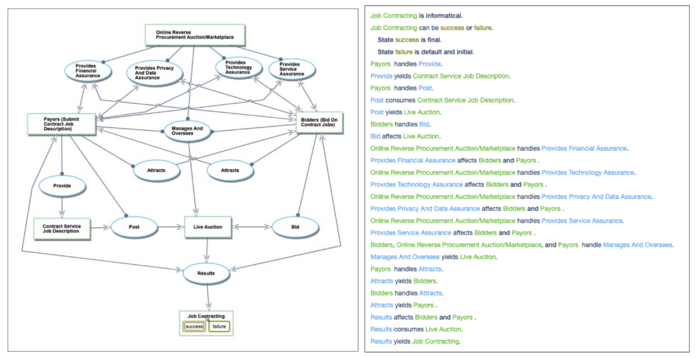Difference between revisions of "Online Reverse Procurement Marketplaces and Auctions"
| Line 35: | Line 35: | ||
(declining margin shows broad acceptance and use along with industry maturity) | (declining margin shows broad acceptance and use along with industry maturity) | ||
''' Transaction Speed [ | ''' Transaction Speed [Seconds] ''' | ||
[measured from payor’s initial interest in seeking contract work to contracting, and does not include fulfillment time (which may or may not be shortened)] | [measured from payor’s initial interest in seeking contract work to contracting, and does not include fulfillment time (which may or may not be shortened)] | ||
Revision as of 23:18, 4 November 2019
Technology Roadmap Sections and Deliverables
Roadmap Overview
Clear and unique identifier:
3RPM - Reverse Procurment Markets
This Roadmap focuses on online reverse procurement marketplaces and auctions, which are online marketplaces and auctions where service providers bid on different service requests from people and companies in need of contract work. Examples include Upwork, Mechanical Turk, and other industry specific markets and auctions.
The chosen figure of merit is user base, measured as either active buyers (of products) or service providers (for services). We have chosen to segment by several major e-commerce platforms of both services and products, which generally show the relative scope and growth of each sector. Figure of Merit: User Base [# buyers of products, providers of services] Theoretical Limit: World Population (all transactions for goods/services are online)
The technology that we will consider through a technology roadmap is online reverse procurement marketplaces and auctions, which are online marketplaces and auctions where service providers bid on different service requests from people and companies in need of contract work. Examples include Upwork, Mechanical Turk, and other industry specific markets and auctions.
Design Structure Matrix (DSM) Allocation
Roadmap Model using OPM
Figures of Merit
Scale [%] [$ of services transacted online/$ of total services transacted online & offline]
User Base [# Total Active Users] (can subdivide to separate sides of market: buyers and service providers)
Average Margin [%] [average of market fee / total transaction value] (declining margin shows broad acceptance and use along with industry maturity)
Transaction Speed [Seconds] [measured from payor’s initial interest in seeking contract work to contracting, and does not include fulfillment time (which may or may not be shortened)]
Alignment with Company Strategic Drivers
Positioning of Company vs. Competition
Technical Model
Financial Model
Key Publications, Presentations and Patents
A. Patents
Information about patents is set forth below. Unlike in the section concerning literature review, in an abundance of caution, we stayed close to the abstract definitions in describing these technologies. We also felt that these abstracts provided the best explanation of the patented technology. As shown below, eBay was a forerunner in developing technology and processes that undergird e-commerce today.
Name: Information presentation and management in an online trading environment
Patent #: 6058417
Inventors: Hess; Martin L. (Aptos, CA), Wilson; Michael K. (Los Gatos, CA)
Assignee: eBay Inc. (San Jose, CA)
Date: May 2, 2000
Abstract: A method and apparatus for information presentation and management in an online trading environment are provided. According to one aspect of the present invention, person-to-person commerce over the Internet is facilitated by providing prospective buyers the ability to quickly preview items for sale. Images are harvested from a plurality of sites based upon user-supplied information. The user-supplied information includes descriptions of items for sale and locations from which images that are to be associated with the items can be retrieved. Thumbnail images are created corresponding to the harvested images and are aggregated onto a web page for presentation at a remote site. According to another aspect of the present invention, a user may submit a query to preview items for sale. After receiving the query, thumbnail images corresponding to items that satisfy the user query are displayed, each of the thumbnail images previously having been created based upon a user-specified image.
Name: Method and apparatus for verifying the identity of a participant within an online auction environment
Patent #: 6466917
Inventors: Goyal; Anoop (East Palo Alto, CA), Poon; Alex D. (Los Altos Hills, CA), Wen; Wen (Cupertino, CA)
Assignee: eBay Inc. (San Jose, CA)
Date: October 15, 2002
Abstract: A method and apparatus for verifying identity of a participant in a network-based transaction facility are described. According to one embodiment, user interface information is provided to the participant via a communications network. The user interface information specifies an identity verification interface for obtaining personal information of the participant. The personal information of the participant is passed to a third party for verification via the communications network. Subsequently, a verification result is received from the third party via the communications network. The verification result is then communicated to the participant via the communications network.
Name: Generic attribute database system for storing items of different categories having shared attributes
Patent #: 6604107
Inventors: Wang; Hsiaozhang Bill (San Jose, CA)
Assignee: eBay Inc. (San Jose, CA)
Date: August 5, 2003
Abstract: Embodiments of the invention provide a method and apparatus for storing multiple items across different categories in a database. One embodiment of the present invention provides a database that includes an attribute value table that has item entries for items of different categories. Each item entry has attribute values for attributes of the items. The database also includes an attribute map table that has attribute map entries. The attribute map entries have attribute map values. Additionally, an attribute value is associated with an attribute map entry, such that the attribute values are translated based on the attribute map values of the associated attribute map entry. In one embodiment, the translating of an attribute value includes determining an attribute type associated with the attribute value.
Name: Method and system for supplying automatic status updates using electronic mail
Patent #: 7139726
Inventors: Fisher; Alan S. (Fremont, CA), Kaplan; Samuel Jerrold (Hillsborough, CA)
Assignee: eBay Inc. (San Jose, CA)
Date: November 21, 2006
Abstract: A system is disclosed for automatically updating the status of customers’ orders and shipments via electronic mail without using a human attendant to create and send the electronic mail messages. Preferably implemented in software, the updating system allows a large set of customers to be periodically updated over a computer or communications network via electronic mail. The system includes a database for maintaining order and shipping status and other relevant information.
Name: Generic attribute database system
Patent #: 6778993
Inventors: Wang; Hsiaozhang Bill (San Jose, CA)
Assignee: eBay Inc. (San Jose, CA)
Date: August 17, 2004
Abstract: Embodiments of the invention provide a method and apparatus for storing multiple items across different categories in a database. One embodiment of the present invention provides a database that includes an attribute value table that has item entries for items of different categories. Each item entry has attribute values for attributes of the items. The database also includes an attribute map table that has attribute map entries. The attribute map entries have attribute map values. Additionally, an attribute value is associated with an attribute map entry, such that the attribute values are translated based on the attribute map values of the associated attribute map entry. In one embodiment, the translating of an attribute value includes determining an attribute type associated with the attribute value.
B. Literature Review
We considered a variety of articles, beyond those listed below, and focused our discussion on five important articles, which include early analysis of e-commerce and online auctions and more recent consideration of online procurement marketplaces.
In considering the evolution of e-commerce, we started with MIT graduate David Lucking-Reiley’s early work on electronic auctions and e-commerce in general, reviewing three articles (David Lucking-Reiley, 2000; David Lucking-Reiley & Daniel F. Spulber, 2001; Lucking-Reiley, 2000).
David Lucking-Reiley considered internet auctions in “Auctions on the Internet: What’s Being Auctioned, and How?” (Lucking-Reiley, 2000). Lucking-Reiley canvassed the history of internet auctions dating back to the mid-1990’s, which were often completed with meager technological support (Lucking-Reiley, 2000). The paper went on to describe the composition of popular internet auctions in terms of volume, velocity, products, business models, and auction formats (Lucking-Reiley, 2000).
Also in 2000, Lucking-Reiley provided more detail on auction theory as applied to e-commerce (David Lucking-Reiley, 2000). Vickrey auctions, achieving true value bids through second price auctions, and their precursors were explained in detail (David Lucking-Reiley, 2000). This paper provided an in depth historical treatment of commerce in general, from the lens of auction development over time (David Lucking-Reiley, 2000).
In “Business-to-Business Electronic Commerce,” Lucking-Reiley and Daniel F. Spulber provide an early analysis of the potential of e-commerce (David Lucking-Reiley & Daniel F. Spulber, 2001). They promote the vast potential, now realized, of electronic transactions, and detail the cost efficiencies from automated transactions, the benefits of market making including reduced search costs and other marketplace advantages, expected consolidation of marketplace due to returns to scale, and organizational design impacts (David Lucking-Reiley & Daniel F. Spulber, 2001).
Next, we reviewed more recent articles concerning the gig economy and the presence of procurement marketplaces on the internet (Ljungh, 2019; Mortleman, 2018; Popiel, 2017).
In “Are the Workers in the On-Demand Economy Employees, Independent Contractors, or a Hybrid Category?”, Doina Ljungholm tackles a critical question and potential limitation in the growth of online procurement auctions and marketplaces, namely, the legal reality of online workers (Ljungh, 2019). Ljungholm details primary considerations and concerns of the on-demand workers that fuel portions of the e-commerce world (Ljungh, 2019). Notably, many of the considerations, both from the business and worker perspectives gather around variability and flexibility, for both sides (Ljungh, 2019).
In “Gig for Victory,” Jim Mortleman describes the increasing need for on-demand “gig” workers and the reality that higher order jobs are now being worked by ad hoc contractors (Mortleman, 2018). One outstanding question, whether highly variable service quality is an initial learning curve or a permanent state of a distributed marketplace, is considered in some detail (Mortleman, 2018). Mortleman makes several interesting points concerning frustrations with the corporate world and new offerings such as “teams-as-a-service (TaaS)” to conclude the piece (Mortleman, 2018).
Finally, we identified one article reviewing whether the platform economy is sustainable (Culkin, 2019).
Culkin, B. (2019). Is Platform Capitalism Sustainable? Digital Business Models, On-Demand Labor, and Economic Growth. Journal of Self-Governance & Management Economics, 7(1), 31–36. https://doi.org/10.22381/JSME7120195
David Lucking-Reiley. (2000). Vickrey Auctions in Practice: From Nineteenth-Century Philately to Twenty-First-Century E-Commerce. The Journal of Economic Perspectives, (3), 183.
David Lucking-Reiley, & Daniel F. Spulber. (2001). Business-to-Business Electronic Commerce. The Journal of Economic Perspectives, (1), 55.
Ljungh, D. P. (2019). Are the Workers in the on-Demand Economy Employees, Independent Contractors, or a Hybrid Category? Linguistic & Philosophical Investigations, 18, 119–125. https://doi.org/10.22381/LPI1820197
Lucking-Reiley, D. (2000). Auctions on the Internet: What’s Being Auctioned, and How? Journal of Industrial Economics, 48(3), 227.
Mortleman, J. (2018). Gig for Victory. Computer Weekly, 28–31.
Popiel, P. (2017). “Boundaryless” in the creative economy: Assessing freelancing on Upwork. Critical Studies in Media Communication, 34(3), 220–233. https://doi.org/10.1080/15295036.2017.1282618


